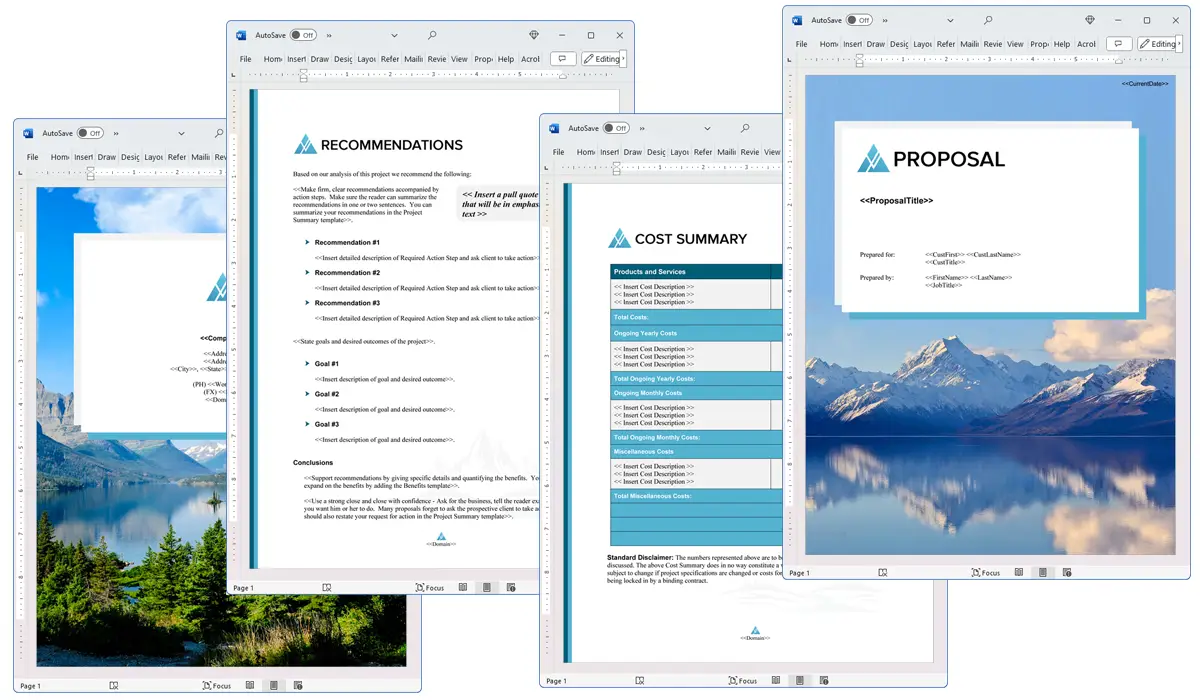What is the Limitations chapter used for?
Proposal Kit Professional Bundle adds more design themes, all six Contract Packs,
a project management library, and Expert Edition software.

Illustration of Proposal Pack Nature #7
We include this Limitations chapter template in every Proposal Pack, along with thousands more. You assemble this chapter with others in various combinations to create custom-tailored business proposals, plans, reports, and other documents. Proposal Packs apply custom visual designs to the templates, giving the final documents a consistent professional finish.
 DOWNLOADABLE, ONE-TIME COST, NO SUBSCRIPTION FEES
DOWNLOADABLE, ONE-TIME COST, NO SUBSCRIPTION FEES
Overview of the Limitations Chapter
When preparing a business proposal, it's crucial to have a clear and comprehensive understanding of what can and cannot be done. The Limitations chapter in a proposal serves this exact purpose. This chapter helps set realistic expectations by outlining the restrictions and constraints that could impact the project's design, development, or deployment. By discussing these aspects upfront, both the proposer and the client have a mutual understanding of the project's scope and boundaries, leading to more efficient project management and fewer misunderstandings during the execution phase.
How is the Limitations Chapter Used?
When used in a business proposal, the Limitations chapter is used to explicitly state any known constraints that might affect project outcomes. These limitations can include budgetary restrictions, time constraints, resource availability, legal or regulatory compliance issues, and technological constraints. By clearly defining these limitations, the proposal writer helps prevent scope creep (where the scope of a project expands while it's in progress) and sets the stage for addressing how these constraints will be managed. This chapter is particularly important in industries where external factors heavily influence project delivery.
What is Included in the Limitations Chapter?
Typically, the Limitations chapter includes:
- Budget Constraints: Details on the financial limits for the project.
- Time Restrictions: Any deadlines that must be met within the project timeline.
- Resource Availability: Information on personnel, equipment, or materials that are limited.
- Regulatory or Legal Constraints: Compliance issues that must be adhered to during the project.
- Technical Limitations: Limitations due to current technology, or systems in place that might affect the project's implementation.
Each limitation is usually accompanied by a brief explanation of its implications and how it may affect the project's outcomes.
Use Case Examples for the Limitations Chapter
In creating a proposal, the Limitations chapter can be applied in various contexts, including but not limited to:
- A proposal for Personal Care Services might discuss limitations related to legal regulations, client's premises size, or specific client needs that cannot be met.
- A proposal addressing an identified Problem in an organization might outline limitations in existing infrastructure that could hamper the implementation of a solution.
- In proposals that focus on potential Negatives, such as risk assessments, the Limitations chapter can detail factors that could lead to less-than-ideal outcomes and how these will be mitigated.
Key Takeaways
- The Limitations chapter is vital for setting realistic project scopes and expectations.
- It helps in outlining all known constraints that could impact the project.
- The inclusion of this chapter prevents scope creep and aids in smoother project management.
- It is particularly important in proposals within tightly regulated industries or those heavily dependent on fixed resources.
- Understanding and clearly documenting project limitations ensures better preparedness and client satisfaction.

Illustration of Proposal Pack Painter #4
 What Our Clients Say
What Our Clients SayEarlier this year I submitted my first RFP bid and was very excited to find this wonderful product. The professional quality of the Contemporary Proposal Kit along with the Wizard helped win my current contract. Both were very intuitive and made writing a snappy proposal much easier."
Workforce Development Coordinator
Columbia River Inter-Tribal Fish Commission
 4.7 stars, based on 849 reviews
4.7 stars, based on 849 reviewsAlternate Chapters
Related Chapters
Samples Using the Limitations Chapter
Document Layouts Using the Limitations Chapter

The Limitations chapter and other chapters are integrated into a Word document as illustrated here in the Proposal Pack Outdoors #4 design theme. There are hundreds of design themes available, and every design theme includes the Limitations chapter template.
A proper business proposal will include multiple chapters. This chapter is just one of many you can build into your proposal. We include the complete fill-in-the-blank template in our Proposal Pack template collections. We also include a library of sample proposals illustrating how companies in different industries, both large and small, have written proposals using our Proposal Packs. This template will show you how to write the Limitations.
We include a chapter library for you to build from based on your needs. All proposals are different and have different needs and goals. Pick the chapters from our collection and organize them as needed for your proposal.
Using the Proposal Pack template library, you can create any business proposal, report, study, plan, or document.
The Wizard software includes an AI Writer, which will write the content of this and any other chapter of your document. Use the AI Writer to do the heavy lifting, writing the first draft of your proposal or business document in minutes.
 Ian Lauder has been helping businesses write their proposals and contracts for two decades. Ian is the owner and founder of Proposal Kit, one of the original sources of business proposal and contract software products started in 1997.
Ian Lauder has been helping businesses write their proposals and contracts for two decades. Ian is the owner and founder of Proposal Kit, one of the original sources of business proposal and contract software products started in 1997.By Ian Lauder
 Published by Proposal Kit, Inc.
Published by Proposal Kit, Inc.


 Cart
Cart
 Facebook
Facebook YouTube
YouTube Bluesky
Bluesky Search Site
Search Site